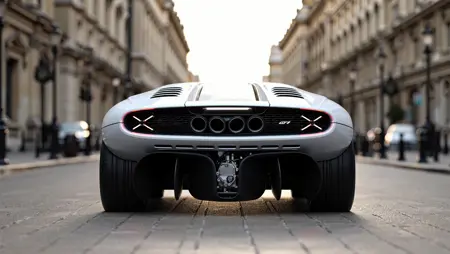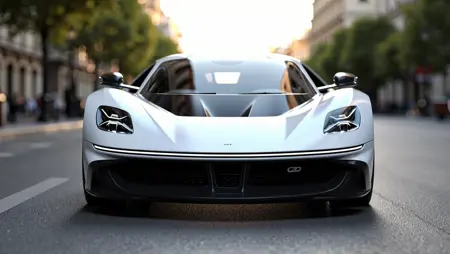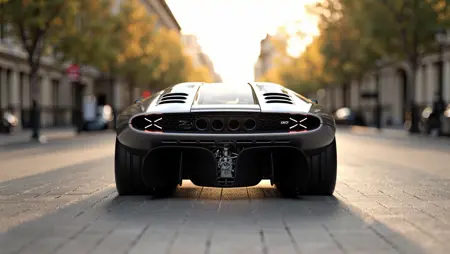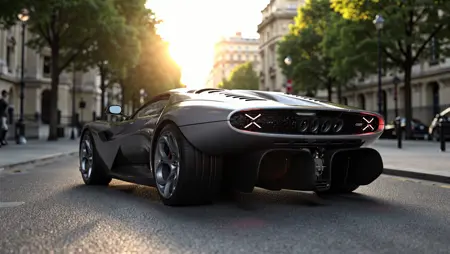Garagisti & Co GP1 - 2025
詳細
ファイルをダウンロード
このバージョンについて
モデル説明
アナログの解毒剤:Garagisti GP1の自然吸気V12は、電動未来への拒絶である
Garagisti GP1は、現代自動車産業が電動化、ターボチャージャー、デジタルインターフェースに集中する中で、大胆かつ明確にアナログなハイパーマシンプロジェクトである。アルゴリズム最適化されたパフォーマンスを追求するのではなく、英国のGaragisti & Co.は、過去の偉大なGTツアラーへの精神的継承となる、純粋でドライバー中心のマシンを生み出している。この文書では、GP1の核心的哲学、技術仕様、デザイン言語、マーケティング戦略を簡潔にまとめている。
エトス:歴史に根差した反乱
「Garagisti」という社名そのものが、同社のアイデンティティの基盤となっている。これは1950年代、エンツォ・フェラーリが小さなガレージで活動し、自らの支配に挑戦し始めた革新的な英国F1チームに対して用いた軽蔑的な呼称に由来する。しかし、これらのチームはこの呼び名を誇りとして受け入れ、手作業による独創性と反骨精神を称えた。Garagisti & Co.はこの名称を採用することで、ブランドの伝統を守る必要も、企業の制約に配慮する必要もない、現代の異端児、しなやかなスタートアップとして位置づけている。
GP1のインスピレーションは、共同創設者であるマリオ・エスキュドロの個人的な体験に深く根ざしている。彼のドライブへの情熱が、稀少なランボルギーニ・コウタッシュに何千マイルも走行する体験へとつながり、クラシックスーパーカーの長距離走行における実用的限界を明らかにした。GP1はその体験への直接的な対応として、「真のGTツアラーかつ一般道路用車両」として設計され、実用的な荷物スペースや適切な室内ノイズレベルといった機能を備えている。この本物の出自は、プロジェクトに高い信頼性を与え、単なるビジネスモデルに基づくプロジェクトとは明確に区別している。同社は「マスターたちの連合」として自己を位置づけ、世界最高レベルの専門家たちが清浄なビジョンを追求できる体制を整え、機動性を保ちながら高品質な製品を生み出している。
機械的ハート:V12とマニュアルトランスミッション
Garagisti GP1は、現代のパワートレインのトレンドを断固として拒絶することを特徴としている。その核心には、イタリアのレース用エンジンメーカーであるItaltecnica Srlが開発した、完全な新設計の6.6リットル自然吸気V12エンジンが搭載されている。これは既存エンジンの流用ではなく、感覚的で高回転型の体験を目的に設計された専用ユニットである。このエンジンは、最低800馬力、700Nmのトルクを発生し、かつ「背筋が震える」9,000rpmまでのレッドゾーンを実現する。自然吸気V12へのこだわりは、業界が小型化・ターボ化・ハイブリッド化にシフトしている中で、力強いメッセージである。
さらに、GP1の最も革新的な特徴は、モータースポーツ専門企業Xtracが開発した6速マニュアルトランスミッションである。瞬時にギアチェンジ可能なデュアルクラッチトランスミッションが主流となる中、マニュアルトランスミッションを選ぶことは、GP1の核心的哲学である「人間と機械の遮断されないつながり」を象徴している。この選択は、ラップタイムよりもドライバーの関与と技術を重視するニッチなオーナー層に直接訴える、決定的な差別化要因である。
パフォーマンスは車体の軽量化によってさらに強化されている。GP1はF1スペシャリストのDexetが供給するカーボンファイバーチャーシャとモノコックを基盤とし、乾燥重量をわずか1,000kg(2,200ポンド)に抑えることを目標としている。この極限の軽量化により、抜群の出力重量比と比類のない機動性が実現される。ブレーマ(ブレーキ)とオーリンズ(サスペンション)といった有名サプライヤーの高性能部品がさらに、GP1の真剣なエンジニアリングとモータースポーツの信頼性を裏付ける。他の現代ハイパーマシンが複雑なハイブリッドシステムに依存するのに対し、GP1は強力なエンジンと軽量なシャーシでパフォーマンスを実現するという点で、圧倒的な代替案となっている。
デザイン:形と機能の調和
GP1のデザインは、元ブガッティ・元リマックのデザイナー、アングェル・グエラが手がけ、ノスタルジーと現代性の完璧なバランスを実現している。外観は1980~90年代の「ウエッジ・エラ」に強く影響されており、鋭角的なラインと「古典的なウエッジシルエット」で、ランボルギーニ・コウタッシュやランチア・ストラートスゼロといったガンディーニ設計のアイコンに敬意を表している。デザインは「視覚的に純粋」とされ、巨大なウイングやダイブプレーンを過剰に使用しない。その代わり、GP1は洗練されたグラウンドエフェクトエアロダイナミクスにより、最大850kgのダウンフォースを生み出し、巨大なリアディフューザーを用いて、清潔でタイムレスなラインを保つ。
このミニマリズムの哲学はインテリアにも貫かれている。コクピットは「ドライバー中心」「ほぼスクリーンなし」とされ、大型のセンターコンソールディスプレイを排除し、タッチ感のある制御装置を採用している。ツインコクピットレイアウトと中央スパインは、カレラGTを彷彿とさせ、ドライバーとマシンの直接的でごちゃごちゃしない関係性を実現している。これは、現代ハイパーマーケットを支配するデジタル重視のインテリアとの明確な対比であり、GP1がドライビング体験の純粋さにこだわっていることを強調している。
マーケティングポジショニングと総括
GP1のビジネスモデルは極限の希少性に基づいている。生産台数は道路使用車両として厳格に25台に限定され、すべて手作業で仕上げられ、顧客の要望に合わせてカスタマイズされる。価格は245万ポンド(税別)と高額である。新興ブランドとして信頼を築くため、Garagisti & Co.は最初の12名の購入者向けに「オープンドアーズ」プログラムを展開し、開発プロセスへの前例のないアクセスを提供している。このユニークな顧客参加戦略は、顧客をパートナーおよびブランドアンバサダーに昇格させる。現在、プロジェクトはレンダリング段階にとどまっているが、世界トップレベルのパートナー網によって、仮想車両(バポアウェア)になるリスクを大幅に軽減している。
結局のところ、Garagisti GP1は単なる自動車ではなく、哲学的声明である。それは、ハイパーマシンの未来を、より多くのパワーとテクノロジーで定義するのか、それとも、人間と機械のより直接的で感覚的なつながりで定義するのか、という重要な問いを投げかける。GP1の遺産は、最高速記録を塗り替えることではなく、アナログでドライバー中心の体験を求める市場が、今なお生き、繁栄していることを証明することにある。










